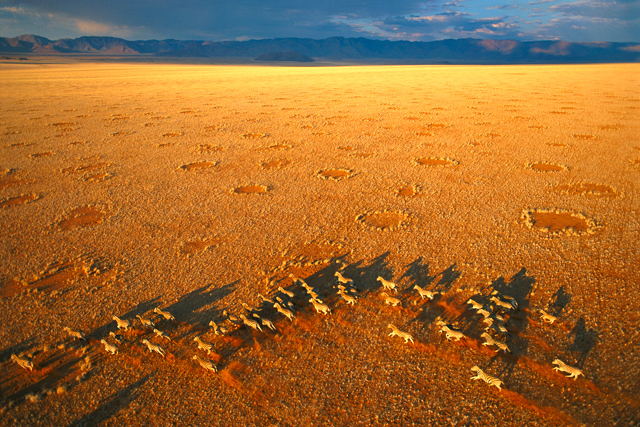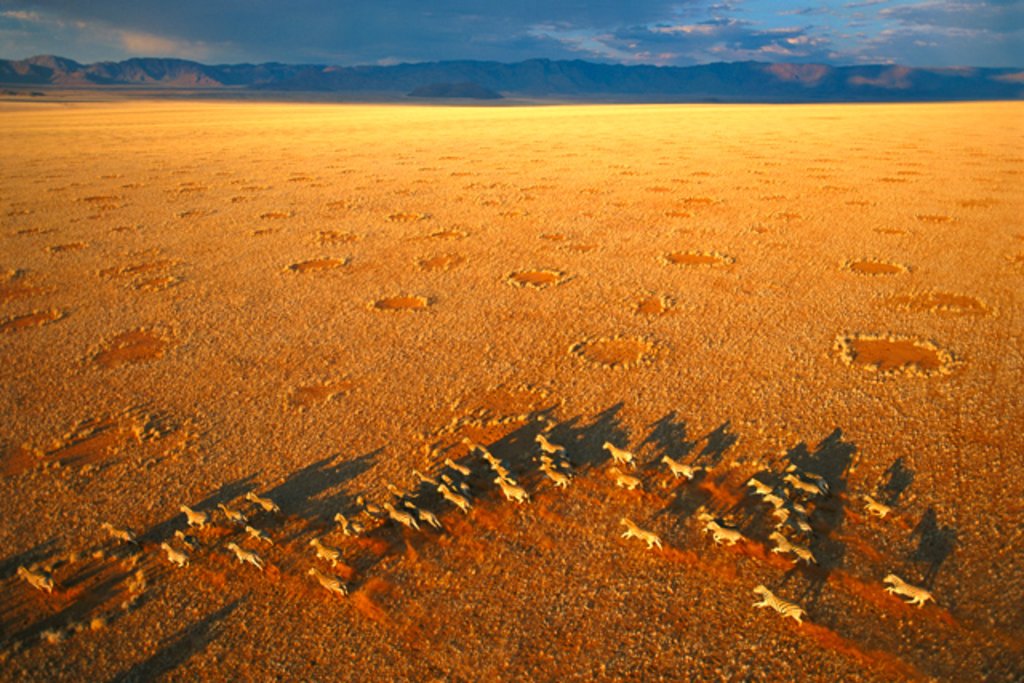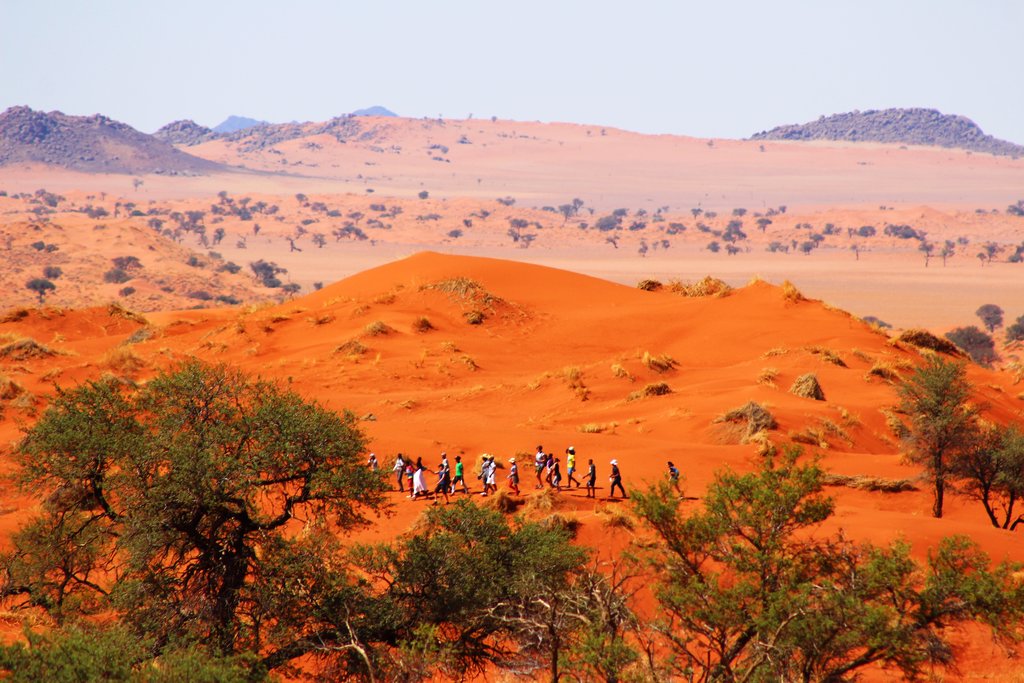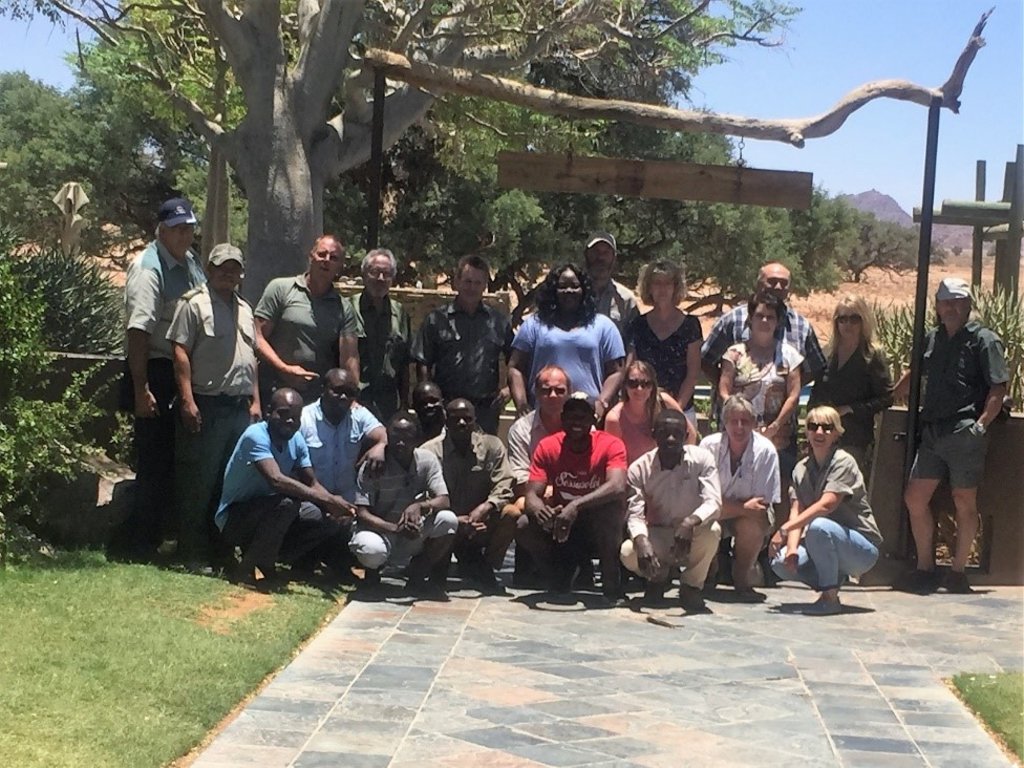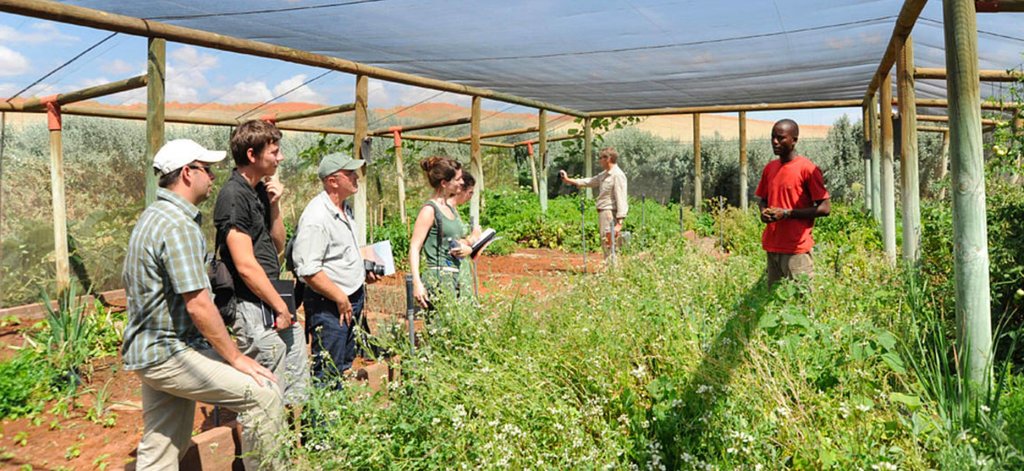Restoration of game migration routes across the Namib Desert [Намибия]
- Создание:
- Обновить:
- Составитель: Ibo Zimmermann
- Редактор: –
- Рецензенты: Rima Mekdaschi Studer, Simone Verzandvoort, Donia Mühlematter
NamibRand Nature Reserve
approaches_3286 - Намибия
- Полная аннотация в формате PDF
- Полная аннотация в формате PDF для вывода на печать
- Полная аннотация в формате интернет-страницы
- Полная аннотация (неотформатированно)
- Restoration of game migration routes across the Namib Desert: 2 ноября 2021 г. (public)
- Restoration of game migration routes across the Namib Desert: 6 октября 2018 г. (inactive)
- Restoration of game migration routes across the Namib Desert : 13 апреля 2018 г. (inactive)
- Restoration of game migration routes across the Namib Desert : 23 февраля 2018 г. (inactive)
- Restoration of game migrations across Namib Desert: 12 января 2018 г. (inactive)
Просмотреть разделы
Развернуть все Свернуть все1. Общая информация
1.2 Контактные данные специалистов и организаций, участвующих в описании и оценке Подхода
Название проекта, содействовавшего документированию/оценке Подхода (если применимо)
NamibRand Nature ReserveНазвание организации (-ий), содействовавших документированию/оценке Подхода (если применимо)
Namibia University of Science and Technology ( NUST) - Намибия1.3 Условия, регламентирующие использование собранных ВОКАТ данных
Когда были собраны данные (на местах)?
01/11/2017
Составитель и ответственный/-ые специалист(-ы) согласны с условиями, регламентирующими использование собранных ВОКАТ данных:
Да
2. Описание Подхода УЗП
2.1 Краткое описание Подхода
Seventeen former sheep farms have been joined to form the world’s largest private nature reserve aimed at regenerating biodiversity to support high-quality low-impact tourism, environmental education and research. All farm owners are members of the management association.
2.2 Подробное описание Подхода
Подробное описание Подхода:
The NamibRand Nature Reserve is a not-for-profit organisation in south-western Namibia. It was founded in 1984 through the initiative of one farm owner, Albi Brueckner, who agreed, with 16 neighbouring farmers, to jointly manage their 215,000 ha for nature conservation and tourism. Its aims are:
To conserve biodiversity for the benefit of future generations and protect the sensitive and fragile environment.
To create a nature reserve with a healthy and functioning ecosystem, providing a sanctuary for flora and fauna, and to facilitate seasonal migratory routes in partnership with neighbours.
To promote sustainable utilisation – through ecologically sustainable and high-quality tourism and other projects.
To achieve a commercially viable operation to ensure continuity and financial independence.
The NamibRand Nature Reserve’s contributions to biodiversity conservation, in accordance with the environmental management plan, include the following:
• Removal of over 2,000 km of fencing to reinstate wildlife migration routes.
• Re-introduction of giraffe and cheetah.
• Bolstering numbers of red hartebeest and plains zebra.
• Removal of alien invasive vegetation such as Prosopis species and replacing these with indigenous Acacias.
• Zonation according to land use areas, including the setting aside 15% of the reserve as a wilderness area.
• Limiting overnight visitors to an average of one bed per 1,000 ha, and 25 beds per location.
• Conducting annual game counts, with results posted on the website www.namibrand.org
• Monitoring the endemic Hartmann’s mountain zebra through the use of camera traps. Results are at: http://www.nnf.org.na/project/mountain-zebra-project/13/1/12.html
• Continuous monitoring of drivers and determinants of environmental change to guide the management plan. Results are posted online at: http://www.landscapesnamibia.org/sossusvlei-namib/rainfall-monitoring
• Hosting researchers to study game migration routes. Results of wildlife monitoring, through the use of GPS collars are at: http://www.landscapesnamibia.org/sossusvlei-namib/research
• Hosting the Namib Desert Environmental Education Trust (NaDEET), to empower and educate schoolchildren for a sustainable future. It operates an environmental education and sustainable living centre (www.nadeet.org).
• A lighting management plan to qualify as an international dark sky reserve that avoids negative consequences of light pollution on biodiversity – which can interfere with animal navigation, reduce the hunting success of predators and prevent moths from pollinating (http://www.darksky.org/idsp/reserves/namibrand)
• A water management plan, including monitoring of the impact of a water hole on the surrounding vegetation.
• Implementation of tourism and land use zonation plans.
• Capture and sale of live game for wildlife population management purposes.
• Plans to develop a horticultural project to grow indigenous medicinal plants for commercial production, creating local jobs and income for conservation.
Rangeland management is achieved largely through continual monitoring and control of animal populations, and the balance between functional groups of their species, and turning off the water supply where grasses are in need of rest. Local outreach efforts focus mainly on predator-livestock management on neighbouring farms.
Stakeholders comprise the land owners, who agree on joint management, and the tourism concessionaires who operate in the reserve under contract. The reserve employs 12 people who are responsible for day-to-day management and maintenance. Biodiversity and land management are funded from park fees collected by the concessionaires from tourists who stay at their establishments. This small management team is possible, because tourism concessionaires offer scenic game drives across the reserve, while on the lookout for required action. For example, guides report issues such as leaking water pipes, unusual wildlife sightings, injured animals, and trespassers (etc.) to reserve managers, who can then react.
Land owners who have connected their land to the reserve and are members of the NamibRand Nature Reserve Association have the option of serving as directors of the association, with joint decision making powers. Those who choose not can still contribute to the strategic mission of the reserve at annual general meetings.
2.3 Фотографии, иллюстрирующие Подход
2.4 Видеоматериалы по применению Подхода
Комментарий, краткое описание:
Short introduction to the reserve
https://www.youtube.com/watch?v=QVQgJlBXn78
Дата:
01/04/2015
Место:
NamibRand Nature Reserve
Автор съемки:
IUCN-PAPACO
Комментарий, краткое описание:
View of landscapes in the reserve
https://www.youtube.com/watch?v=8LZI2ZtPhbg
Дата:
15/09/2014
Место:
NamibRand Nature Reserve
Автор съемки:
Christine Guillot, Etendues Sauvages
Комментарий, краткое описание:
Organic garden at lodge in the reserve
https://www.youtube.com/watch?v=U7RVKfeQ-0M
Дата:
05/04/2016
Место:
NamibRand nature Reserve
Автор съемки:
Ticket2Utopia – Dr. Paul Goddard
2.5 Страна/ регион/ место, где применялся Подход
Страна:
Намибия
Административная единица (Район/Область):
Southwestern Namibia in the Namib Desert.
Map
×2.6 Даты начала и окончания реализации Подхода
Год начала реализации:
1984
Если год начала реализации Подхода достоверно неизвестен, дайте примерную оценку:
10-50 лет назад
Комментарии:
The first property was purchased in 1984. The reserve was registered as a Game Reserve in 1992 and registered as the NamibRand Nature Reserve, an Association Not for Gain, in 2002
2.7 Тип Подхода
- недавняя местная инициатива/ инновация
2.8 Каковы цели/ задачи Подхода
The approach aims, through participatory land use planning, to restore ecosystem function in the reserve and its surroundings to support high-quality, low-impact tourism that provides the means to support environmental education and other conservation projects.
The overall Strategic Vision of the NamibRand Nature Reserve is to manage the Pro-Namib area, alongside the Namib Desert, for the enhanced conservation of the landscape and its biodiversity.
2.9 Условия содействующие применению Технологии/ Технологий в рамках Подхода или затрудняющие его
Социальные/ культурные/ религиозные нормы и ценности
- содействуют
The area was historically visited by migrant San people and more recently by Nama people, who have settled permanently elsewhere. Since no people were living permanently in this hyper-arid ecosystem, the use of the area exclusively for nature conservation remains uncontested.
Наличие/ доступность финансовых ресурсов и услуг
- содействуют
The establishment of the reserve was initially possible through the ample financial resources of wealthy, altruistic and philanthropic investors.
- затрудняют
The properties that make up the NamibRand Nature Reserve are located in a hyper-arid ecosystem. Farmers who attempted livestock farming there in the past almost all failed to establish economically viable farms, and most of them overextended themselves financially, resulting in the foreclosure of their farms. For this reason, the area became known as the “Bankruptcy Belt”. Banks were, in the past, extremely reluctant to extend loans to landowners in this area, due to the low value and low agricultural potential. In recent years, the successes of conservation and tourism have changed this situation and banks are now prepared to accept farms with such land use as collateral for extending loans.
Институциональные условия
- содействуют
Progressive government company laws, such as the possibilit y to register a Section 21 company (“Association Not for Gain”) allow financial resources to be re-invested in conservation so as to further the objectives of the non-profit association. Section 21 companies also do not have to pay company taxes to the government.
Сотрудничество/ координация действий
- содействуют
Articles of Association and the management plan allow for the creation of a management team that effectively coordinates all activities on the reserve.
Нормативно-правовая база (землевладение, права на земле- и водопользование)
- содействуют
Rights and therefore the possibility to benefit from wildlife are enshrined in the Nature Conservation Ordinance of 1975.
- затрудняют
The current Nature Conservation Ordinance of 1975 does not allow for the registration of private nature reserves. The status of the land with the government thus remains as agricultural land, and law enforcement has to rely on common law such as trespassing on private property.
Программные документы/ руководящие установки
- содействуют
Progressive, enabling policies of the Ministry of Environment and Tourism, such as the tourism policy and the parks and neighbours policy ensure meaningful collaborations between the public and the private sector. See http://www.met.gov.na
Управление земельными ресурсами (принятие решений, осуществление и контроль за выполнением)
- содействуют
Good governance is achieved through the adoption of Articles of Association and management plans. These guide decision-making and enable implementation. A set of rules, called the Vade Mecum, enable enforcement.
Осведомленность в области УЗП, доступность технической поддержки
- содействуют
Good networking, membership to various professional bodies and collaboration with universities and researchers ensure good knowledge about sustainable land management and technical support.
Рынки (для приобретения материалов и услуг, продажи продукции) и цены
- содействуют
A well-established tourism market to Namibia ensures a steady stream of visitors to the NamibRand Nature Reserve, enabling the collection of park fees and thus ensuring income for the reserve.
- затрудняют
The remoteness of the reserve, 150km from the nearest town, results in expensive transport charges for goods and inflated prices for professional services.
Объем работ, доступность рабочей силы
- содействуют
Guides from tourism concessions on the reserve allow for sharing of workloads. Availability of human resources in the region is ample.
3. Участие и распределение ролей заинтересованных сторон
3.1 Заинтересованные стороны, участвующие в реализации Подхода и их роли
- местные землепользователи/ местные сообщества
17 former livestock farms owned by 12 companies, now converted to tourism enterprises
Some of them serve as directors of the NamibRand Nature Reserve Association, for joint decision making
- эксперты по УЗП/ сельскому хозяйству
12 reserve management staff
To manage the reserve
- ученые-исследователи
Visiting researchers from various academic institutions
To conduct research to help with applied research for management and "interest research" such as on “fairy circles”, which can be seen in the cover photo. The origin of these circles of bare soil surrounded by grass is still being disputed among scientists (https://www.youtube.com/watch?v=2VNyo9AoA8I). There is a Wildlife monitoring programme partnership with Namibia University of Science and Technology and the Greater Sossusvlei Landscape Association
- учителя/ преподаватели/ школьники / студенты
4 full-time teachers at NADEET and 10 instructors at hospitality training centre.
To expose about 1000 visiting students per year to environmental education and to provide vocational training to about 100 trainees per year.
- общественные организации
Cheetah Conservation Fund and Giraffe Conservation Fund.
To reintroduce predators and wild herbivore species.
- частный сектор
Neighbouring farms
Co-management of the larger landscape with like-minded neighbours, as indicated at: http://www.landscapesnamibia.org/sossusvlei-namib/
- государственные власти (отвечающие за планирование или принятие решений)
Ministry of Environment and Tourism.
To assist with law enforcement and wildlife monitoring.
- международные организации
Member of IUCN
For advocacy and knowledge sharing.
3.2 Участие местных землепользователей/ местных сообществ на разных стадиях реализации Подхода
| Участие местных землепользователей/ местных сообществ | Перечислите участников и опишите их вовлеченность | |
|---|---|---|
| инициирование/ мотивация | самоорганизация | The founding farm owner approached philanthropic donors to buy neighbouring farms and invest in tourism facilities and environmental education centre. |
| планирование | внешняя поддержка | In 1991, external experts provided advice for planning of the reserve. Influential persons involved included Chris Brown, Hugh Berry and Haino Rumpf of the Ministry of Environment, and Mary Seely of the Desert Research Foundation. |
| выполнение | самоорганизация | Management staff were appointed in 1991, and paid for from the conservation levy raised from use of tourism facilities in the reserve. |
| мониторинг/ оценка | самоорганизация | Reserve management staff do the monitoring, paid for by the conservation levy. |
| research | внешняя поддержка | Research institutions conduct research after paying a small service fee. |
3.4 Принятие решений по выбору Технологии/ Технологий УЗП
Укажите, кто принимал решение по выбору применяемой Технологии/ Технологий:
- в основном землепользователи при поддержке специалистов по УЗП
Поясните:
The Reserve's vision and mission were set up by its directors, who comprise farm owners willing to serve in this decision making role, at the Initiation workshop in 1991. Management actions were then Implemented under the guidance of various specialists.
Поясните на чём было основано принятие решений:
- анализ подробно описанного опыта и знаний по УЗП (принятие решений на основе подтвержденных фактов)
- результаты исследований
- личный опыт и мнения (незадокументированные)
4. Техническая поддержка, повышение компетенций и управление знаниями
4.1 Повышение компетенций/ обучение
Проводилось ли обучение землепользователей/ других заинтересованных лиц?
Да
Укажите, кто проходил обучение:
- землепользователи
- местный персонал/консультанты
- Tourism concessionaires
Тип обучения:
- в ходе работы
- опытные участки
- общие собрания
Тип обучения:
- Exchange visits
Рассматриваемые темы:
Biodiversity conservation, financial management, tourism best practices, principles of co-management, human-wildlife conflict resolution, rehabilitation.
4.2 Консультационные услуги
Есть ли у землепользователей возможность получать консультации?
Да
Укажите, где именно оказываются консультационные услуги:
- на полях землепользователей
- в постоянно функционирующих центрах
Описание/ комментарий:
Advice is provided by the Namibia Chamber of Environment, the Namibia Nature Foundation, the Ministry of Environment and Tourism Resource Centre, the Namibia University of Science and Technology, the Giraffe Conservation Fund and other wildlife biologists on issues such as determination of wildlife carrying capacities.
4.3 Институциональная (организационная) поддержка
В ходе реализации Подхода были ли организованы новые институциональные структуры или поддержаны уже существующие?
- да, существенно
Укажите уровень, на котором структуры были укреплены или вновь созданы:
- местные
Опишите организацию, функции и ответственность, членство и т.д.
NamibRand Nature Reserve Association. All land owners are members, who elect the directors. They manage the reserve according to an agreed strategy.
Укажите тип поддержки:
- финансовая
Подробнее:
Hiring of lawyers and auditors/accountants to establish the association.
4.4 Мониторинг и оценка
Являются ли мониторинг и оценка частью Подхода?
Да
Комментарии:
Impacts are monitored to feed back into management.
Если да, будет ли данный документ использоваться для мониторинга и оценки?
Нет
4.5 Научные исследования
Были ли научные исследования частью Подхода?
Да
Укажите темы исследований:
- экология
Напишите подробнее и назовите тех, кто выполнял исследования:
Determination of wildlife carrying capacities by wildlife biologists.
5. Финансирование и внешняя материальная поддержка
5.1 Годовой бюджет мероприятий по УЗП в рамках Подхода
Если точный годовой бюжет неизвестен, укажите примерный диапазон затрат:
- 100 000-1 000 000
Комментарий (например, основные источники финансирования/ ключевые доноры):
Self funded from conservation levy collected from tourism income.
5.2 Финансирование и внешняя материальная поддержка, предоставляемая землепользователям
Предоставлялась ли землепользователям финансовая/ материальная поддержка для применения Технологии /Технологий?
Нет
5.4 Кредитование
Предоставлялись ли в рамках Подхода кредиты на мероприятия УЗП?
Нет
5.5 Другие методы или инструменты стимулирования
Использовались ли другие методы или инструменты стимулирования для продвижения Технологий УЗП?
Нет
6. Анализ влияния и заключительные положения
6.1 Влияние Подхода
Сумел ли Подход расширить возможности местных землепользователей, повысить участие заинтересованных сторон?
- Нет
- Да, немного
- Да, умеренно
- Да, существенно
Interest in owning land has greatly increased. Land prices have risen and more tourism establishments were built.
Сумел ли Подход дать возможность принимать решения на основе подтвержденных фактов?
- Нет
- Да, немного
- Да, умеренно
- Да, существенно
Through monitoring, to determine wildlife carrying capacity.
Сумел ли Подход помочь землепользователям внедрить и поддерживать технологии УЗП?
- Нет
- Да, немного
- Да, умеренно
- Да, существенно
Research and expert advice drives appropriate management for the ecology. There are no more sheep and associated weeds, while wildlife numbers increased.
Сумел ли Подход улучшить согласованность действий и повысить рентабельность применения практик УЗП:
- Нет
- Да, немного
- Да, умеренно
- Да, существенно
By applying economies of scale. Managed holistically by a small, effective team.
Сумел ли Подход мобилизовать/ расширить доступ к финансовым ресурсам для применения практик УЗП?
- Нет
- Да, немного
- Да, умеренно
- Да, существенно
Through awarding of tourism concessions and collection of park fees.
Сумел ли Подход расширить знания и возможности землепользователей в применении практик УЗП?
- Нет
- Да, немного
- Да, умеренно
- Да, существенно
Through various training and research activities.
Сумел ли Подход расширить знания и возможности других заинтересованных сторон?
- Нет
- Да, немного
- Да, умеренно
- Да, существенно
Through accessing information and gaining knowledge from research.
Сумел ли Подход укрепить сотрудничество между заинтересоваными сторонами/ выстроить механизмы сотрудничества?
- Нет
- Да, немного
- Да, умеренно
- Да, существенно
Through establishment of the association, appointment of the management team and information sharing.
Сумел ли Подход снизить остроту конфликтов?
- Нет
- Да, немного
- Да, умеренно
- Да, существенно
Through implantation of a joint management plan and shared vision.
Сумел ли Подход расширить возможности социально и экономически уязвимых групп?
- Нет
- Да, немного
- Да, умеренно
- Да, существенно
There are no local communities living within the area, but children from all over the country visit the environmental education centre.
Сумел ли Подход содействать гендерному равенству и расширить права и возможности женщин и девочек?
- Нет
- Да, немного
- Да, умеренно
- Да, существенно
Through policies prohibiting gender discrimination, implemented by tourism enterprises.
Сумел ли Подход стимулировать молодежь/ будущее поколение землепользователей заниматься УЗП?
- Нет
- Да, немного
- Да, умеренно
- Да, существенно
Through the environmental education and vocational training centres.
Сумел ли Подход разрешить правовые проблемы землевладения/ землепользования, препятствующие использованию технологий УЗП?
- Нет
- Да, немного
- Да, умеренно
- Да, существенно
Through establishment of the Association for joint management and guidelines that are followed in the management plan.
Сумел ли Подход способствовать улучшению продовольственой безопасности/ качества питания?
- Нет
- Да, немного
- Да, умеренно
- Да, существенно
Through the organic garden of 1 ha irrigated with borehole water and featuring in one of the Youtube videos, the improved financial status of the area and access to meat of culled animals for reserve workers and tourists.
Сумел ли Подход расширить доступ к рынкам?
- Нет
- Да, немного
- Да, умеренно
- Да, существенно
Due to serving tourism needs.
Сумел ли Подход улучшить санитарные условия и доступ к водоснабжению?
- Нет
- Да, немного
- Да, умеренно
- Да, существенно
Workers have access to borehole water pumped for tourism.
Сумел ли Подход привести к более эффективному использованию электроэнергии/ возобновляемых источников энергии?
- Нет
- Да, немного
- Да, умеренно
- Да, существенно
Solar power is used to generate electricity and heat water.
Сумел ли Подход улучшить способность землепользователей адаптироваться к изменениям климата и смягчать последствия катастрофических погодных явлений?
- Нет
- Да, немного
- Да, умеренно
- Да, существенно
Based on naturally adapted species that are able to migrate.
Сумел ли Подход привести к созданию новых рабочих мест/ к расширению возможностей получения дохода?
- Нет
- Да, немного
- Да, умеренно
- Да, существенно
The current land use based on tourism supports times more employees per unit area compared with former sheep farming.
National economy:
- Нет
- Да, немного
- Да, умеренно
- Да, существенно
Contribution to national income through higher wages in the tourism industry.
6.2 Основные причины, побуждающие землепользователей внедрять УЗП
- рост прибыли (доходности) и рентабельности
Through tourism, compared with former sheep farming.
- снижение деградации земель
Reliance on more appropriate land use.
- снижение риска катастрофических погодных явлений
Nature takes better care of itself and is more resilient to drought than sheep farming was.
- снижение объёма работ
Sheep herders are no longer needed and there is a small, efficient management team, assisted by information provided through tour guides when their attention is required.
- престиж, общественное давление/ солидарность
Through membership of the association.
- экологическая сознательность
Forms the vision of the association.
- приобретение знаний и опыта в области УЗП
Improved resource management due to expert knowledge.
- улучшение эстетической привлекательности
There are rules to prevent unsightly buildings and maintain the clear night sky, free from light pollution.
- снижение остроты конфликтов
Through the association constitution and discussions at planning meetings working towards the common goal
- Philantropic
Wanting to do good and contribute to conservation.
6.3 Долгосрочная устойчивость мероприятий в рамках Подхода
Могут ли землепользователи самостоятельно (без внешней поддержки) продолжать применение того, что было реализовано в рамках Подхода?
- да
Если да, опишите как:
Through income largely derived from tourism and partly from sale of captured game animals in accordance with the environmental management plan.
6.4 Сильные стороны/ преимущества Подхода
| Сильные стороны/ преимущества/ возможности по мнению землепользователей |
|---|
| The reserve is centrally and holistically managed by a team. |
| Resilience attained by the large unfenced ecosystem. |
| Land users coming together to sign and form a legally recognised body that is more robust. |
| Tourism is more profitable and sustainable than agriculture for such a hyper arid region. |
| Сильные стороны/ преимущества/ возможности по мнению составителя или других ключевых специалистов |
|---|
| Resilience to climate change through natural resources, using the competitive advantage of nature. |
| Private property excludes communal demands and allows fast and easy decision making on land use. |
6.5 Слабые стороны/ недостатки Подхода и пути их преодоления
| Слабые стороны/ недостатки/ риски по мнению землепользователей | Возможные пути их преодоления/снижения? |
|---|---|
| There is currently no legislative support from government for protection of private land. | The new wildlife bill being drafted makes provision for privately protected areas. |
| In the eyes of the Ministry of Lands, there are only two types of land, either urban and gazetted (e.g. parks) or agricultural (subject to land tax). | Include a third category of land for protected areas, such as the desert margin being non-agricultural. |
7. Справочные материалы и ссылки
7.1 Методы сбора/источники информации
- опросы землепользователей
Chief Executive Officer of the NamibRand Nature Reserve
7.2 Ссылки на опубликованные материалы
Название, автор, год публикации, ISBN:
A Guidebook to the NamibRand Nature Reserve, 2017, ISBN 978-99945-85-14-4
Где опубликовано? Стоимость?
Local bookshops for approximately USD25
7.3 Ссылки на материалы, доступные онлайн
Название/ описание:
Website of NamibRand Nature Reserve
Адрес в сети Интернет:
www.namibrand.org
Название/ описание:
Website of Namib Desert Environmental Education Trust
Адрес в сети Интернет:
www.nadeet.org
Ссылки и модули
Развернуть все Свернуть всеСсылки
Нет ссылок
Модули
Нет модулей


